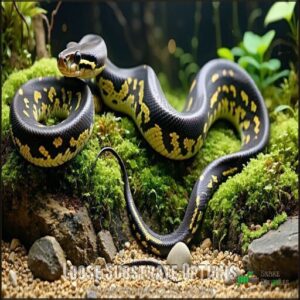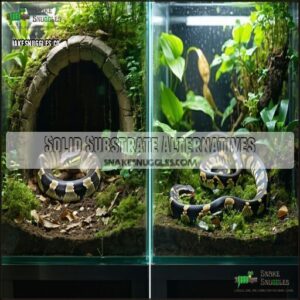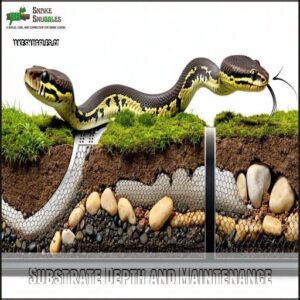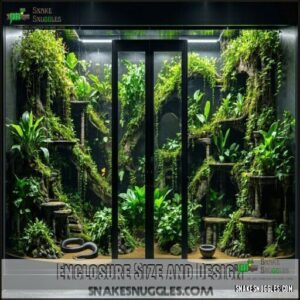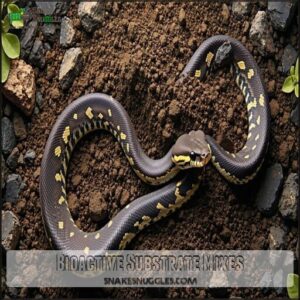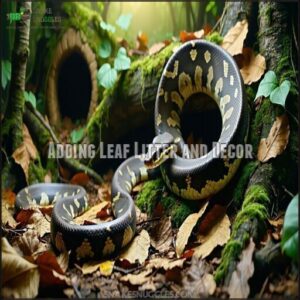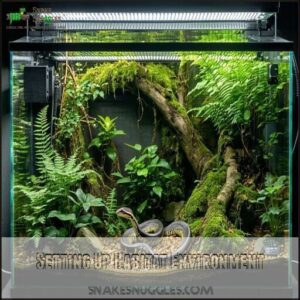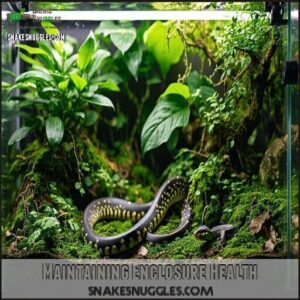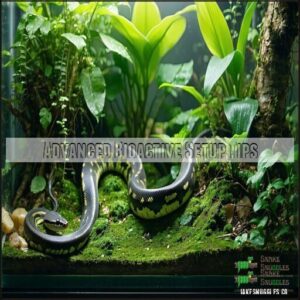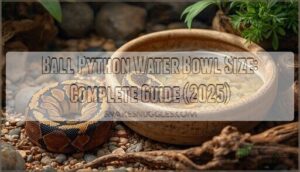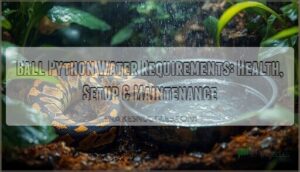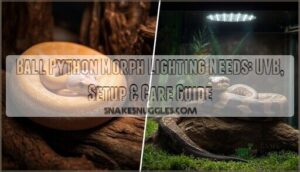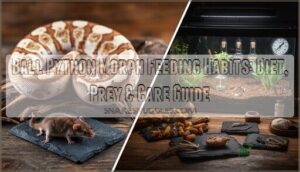This site is supported by our readers. We may earn a commission, at no cost to you, if you purchase through links.
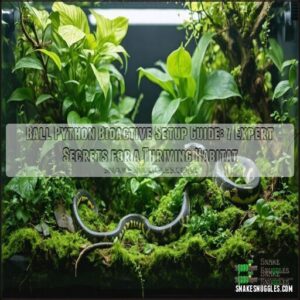 Creating a bioactive setup for your ball python means designing a mini-ecosystem that’s both functional and natural.
Creating a bioactive setup for your ball python means designing a mini-ecosystem that’s both functional and natural.
Start with a loose, moisture-retaining substrate like a mix of coconut husk, topsoil, and sand. Add leaf litter and hides to mimic their wild habitat.
For humidity, aim for 50-60%, using moss or live plants to help. Maintain a temperature gradient—78-80°F on the cool side and 88-92°F in the basking spot.
Introduce cleanup crews like springtails and isopods to manage waste naturally. Keep an eye on humidity and spot-clean as needed.
Want to make it even better? Live plants can elevate both aesthetics and functionality, creating a more natural environment.
Table Of Contents
Key Takeaways
- Use a mix of organic topsoil, coconut coir, and orchid bark for your substrate, and include cleanup crews like springtails and isopods to manage waste naturally.
- Maintain a temperature gradient of 75-95°F and humidity levels between 55-65%, adjusting for shedding periods.
- Add live plants like pothos and natural hides for enrichment, and ensure all materials are non-toxic and securely placed.
- Monitor temperature, humidity, and waste regularly to keep the enclosure healthy and thriving for your ball python.
Choosing Best Substrate
You’ll need a proper substrate mix of 80% organic soil and 20% play sand to create the foundation of your ball python’s bioactive habitat.
Top this mixture with leaf litter and sphagnum moss to maintain the essential 70-80% humidity level your snake requires for peak health.
Loose Substrate Options
Five loose substrate options create the foundation of a thriving ball python bioactive setup. Each offers unique benefits for your serpent’s habitat:
- Organic topsoil (fertilizer-free) forms the base of most substrate mixes
- Play sand improves drainage when mixed at 20% ratio
- Cypress mulch adds texture and helps maintain humidity
- Coco chips (ReptiChip) support natural burrowing behaviors
- Sphagnum moss retains moisture and prevents compaction
To guarantee safety, consider safe substrate options that prevent respiratory irritation.
Solid Substrate Alternatives
Alongside bioactive options, solid substrates provide sterile alternatives for your ball python’s enclosure.
ReptiSoil, EcoEarth, and Plantation Soil offer excellent sterile substrate choices, while coconut chips (ReptiChip) and cypress mulch create texture when mixed into bioactive setups.
Consider using ReptiSoil for ball pythons to promote healthy digging and burrowing behaviors.
For complete ease of cleaning, consider newspaper substrate, shelf liners, or puppy pads—though they sacrifice visual appeal and humidity control for cost savings and snake safety.
Substrate Depth and Maintenance
While solid substrates offer easy cleaning, proper substrate depth is where your ball python’s comfort truly begins.
You’ll need 2-4 inches minimum for standard setups, but bioactive substrates benefit from 3-5 inches to accommodate cleanup crews.
Understanding the importance of bioactive substrate depth is key to a thriving bioactive enclosure.
Remove urates daily, spot clean as needed, and replace non-bioactive substrate every 3-4 months.
Bioactive setups last longer—often a year or more with proper maintenance.
Creating Bioactive Enclosure
You’ll transform your ball python’s enclosure into a self-sustaining ecosystem by setting up a bioactive habitat with the right substrate mix and cleanup crew.
Transform your ball python’s enclosure into a thriving ecosystem where nature handles waste, humidity thrives, and your snake feels truly at home.
Your snake will enjoy a more natural environment that maintains proper humidity levels while beneficial microorganisms and insects handle waste breakdown, creating a more natural environment.
Enclosure Size and Design
Beyond substrate selection, let’s talk about your snake’s home. For a proper ball python bioactive setup, you’ll need the right enclosure size and design.
Your adult ball python thrives in a PVC enclosure measuring at least 4’x2’x2′. This provides:
- Front-opening access for easier maintenance
- Sufficient vertical space for climbing enrichment
- Better humidity retention than glass tanks
Selecting the right supplies can be easy when exploring various enclosure products. Never house multiple snakes together—they’re solitary creatures by nature, and this is crucial for a proper ball python environment to ensure their well-being and bioactive setup success.
Bioactive Substrate Mixes
Creating the perfect bioactive substrate mix for your ball python is like building a miniature ecosystem from the ground up.
Your substrate needs to support beneficial microorganisms while maintaining proper moisture levels.
| Component | Purpose | Ratio |
|---|---|---|
| Organic topsoil | Base material | 40-50% |
| Coconut coir | Moisture retention | 20-30% |
| Orchid bark | Drainage & aeration | 15-20% |
| Charcoal | Filtration | 5-10% |
For ideal results, combine these ingredients thoroughly before adding your cleanup crew of springtails and isopods.
A key component is bioactive substrate depth to support burrowing.
Adding Leaf Litter and Decor
Regularly adding leaf litter transforms your bioactive vivarium into a naturalistic paradise for your ball python.
Sprinkle dried oak or magnolia leaves over your substrate to promote beneficial microorganisms.
Place cork bark pieces strategically as natural hides and enrichment. Add climbing branches for exploration and exercise.
Your enclosure decor should blend aesthetic design with functionality, creating multiple hideaways at different heights where your snake can feel secure. Naturalistic paradise
Setting Up Habitat Environment
You’ll need to create specific temperature zones and maintain proper humidity levels to keep your ball python healthy in its bioactive setup.
The right combination of heating elements and UVB lighting will mimic natural conditions and support both your snake and live plants.
Temperature and Humidity Requirements
Success in maintaining your ball python’s health hinges on precise temperature and humidity control.
Your bioactive setup needs:
- An ideal gradient of 75-80°F cool side to 90-95°F warm side
- Humidity levels between 55-65% (higher during shed)
- Quality monitoring tools like digital thermometers/hygrometers
- Reliable humidity sources such as water dishes and moist substrate
Use thermostat control to prevent overheating and adjust for seasonal changes, ensuring a stable environment with proper humidity levels.
Lighting Options and UVB Needs
Your ball python’s lighting setup is essential for its wellbeing in a bioactive habitat.
While they can survive without UVB lighting, providing a low-intensity T5 HO fluorescent tube (2-6% strength) supports vitamin D synthesis and immune health.
Pair this with full-spectrum LED lighting to maintain plant life and create a natural diurnal cycle.
Position UVB bulbs 9-14 inches above the basking area, replacing them annually to ensure the bioactive habitat remains healthy.
Creating Temperature Gradients
In order to mimic their natural habitat, your ball python needs a proper temperature gradient.
Set up heating methods on one side of the enclosure using a thermostat control system.
Maintain 90-95°F on the warm side and 75-80°F on the cool side, and use digital monitoring tools to track these ranges, as gradient importance can’t be overstated for proper digestion and behavior.
Make seasonal adjustments as needed.
Ball Python Diet and Feeding
You’ll need to feed your ball python appropriately sized rodents every 7-14 days depending on their age and size.
Proper feeding practices, including using frozen/thawed prey and selecting the right meal size, are essential for maintaining your snake’s health in their bioactive habitat.
Rodent Prey and Feeding Frequency
Three essential rodent prey options form the foundation of your ball python’s diet.
Offer frozen-thawed meals every 7-10 days for juveniles and every 10-14 days for adults. Whole prey provides complete nutrition without supplements.
If your snake refuses food, don’t panic—they can fast for weeks. A key aspect involves thawing frozen prey safely to prevent bacterial contamination.
Maintain a consistent feeding schedule to prevent obesity while ensuring proper growth.
Prey Size and Type Recommendations
Typically, your ball python’s prey size should match the thickest part of their body.
Choose appropriately sized frozen rodents for maximum nutrition and digestion.
- Freshly thawed mice – perfect for hatchlings and juveniles, easier to digest
- Medium rats – ideal for most adult ball pythons, providing complete nutrition
- African soft-furred rats – mimics natural prey, often entices picky eaters
- Varied prey options – prevents feeding resistance and guarantees nutritional variety
The selection of these prey options is crucial for the health and well-being of your ball python, as it ensures they receive a balanced diet.
Feeding Tips and Tricks
If your snake refuses frozen rodents, try prey warming by gently heating them to mimic live feeding.
Scenting prey with chicken broth or bedding from live rodents can encourage interest.
Avoid feeding multiple snakes together to prevent aggression.
For feeding enrichment, vary prey sizes or offer frozenthawed meals with tongs.
Understanding refusal reasons helps maintain a stress-free snake feeding routine.
Maintaining Enclosure Health
Keeping your ball python’s enclosure clean and well-maintained is essential for its health and comfort. Regular monitoring of temperature, humidity, and waste buildup guarantees a stable and thriving environment.
Cleaning and Maintenance Schedule
For a healthy bioactive setup, remove feces and urates daily to prevent odors and maintain cleanliness.
Replace non-bioactive substrate every 3-4 months, or refresh bioactive setups as needed.
Clean glass weekly for visibility, and perform regular water changes to avoid contamination.
A thriving bioactive cleanup crew simplifies reptile enclosure maintenance, ensuring your ball python’s habitat stays fresh and inviting.
Common Health Issues and Treatments
Keeping the enclosure clean prevents many ball python health issues.
Watch for respiratory infections, mites, or shedding problems.
Here’s how to address common concerns:
- Mite Control: Use Provent-A-Mite or fipronil sprays.
- Dysecdysis Prevention: Maintain humidity, offer humid hides.
- Burns Treatment: Avoid heat rocks, use thermostats.
Always consult a vet for Cryptosporidium symptoms or severe cases.
Monitoring Temperature and Humidity
A reliable bioactive setup guide starts with monitoring your ball python’s habitat.
Use digital thermometers and humidity probes to track conditions, a temperature gun guarantees surface accuracy, while data logging helps spot trends.
Regularly calibrate your tools for precision.
Maintain humidity between 55-65% and temperature gradients from 75-95°F.
Proper monitoring keeps your python comfortable and thriving.
Advanced Bioactive Setup Tips
To take your ball python’s habitat to the next level, focus on integrating live plants, natural hides, and climbing structures.
These additions both enhance the enclosure’s appearance and support a healthier, more enriching environment for your snake.
Using Live Plants and Hides
Live plants like pothos or ficus add enrichment value and enhance a naturalistic vivarium.
Verify that plant toxicity isn’t a concern for your ball python.
Use a bioactive substrate to support root health and growth.
Incorporate naturalistic hide materials, such as cork flats or bark, to create secure spaces.
These elements balance aesthetics and functionality, enriching your snake’s habitat.
Incorporating Climbing Structures
Adding climbing structures enhances arboreal enrichment, encouraging natural behaviors. Use sturdy materials like cork bark or branches, guaranteeing secure fixtures to prevent accidents.
Place structures at varying heights for climbing enrichment and hiding opportunities. A vital aspect involves using non-toxic materials to guarantee the snake’s safety.
- Select materials: Cork bark, driftwood, or natural branches.
- Ensure safety: Sand rough edges, secure with non-toxic adhesives.
- Strategic placement: Create pathways between hides and basking areas.
Troubleshooting Common Bioactive Issues
If climbing structures are in place, but issues persist, focus on odor control, mold prevention, and pest outbreaks.
A foul smell signals substrate compaction or an imbalanced cleanup crew. Make certain springtails and isopods thrive for proper waste breakdown.
Mold growth is normal, but black mold isn’t—remove it immediately. Maintain ventilation to support your bioactive substrate and invertebrate balance.
Frequently Asked Questions (FAQs)
How to introduce a ball python to enclosure?
Introducing your ball python to its enclosure is like welcoming a guest—keep it calm.
Place it gently inside, make certain the temperature and humidity are stable, and give it a few days to adjust undisturbed.
Can bioactive setups prevent snake stress behaviors?
Bioactive setups can reduce stress behaviors by mimicking natural habitats.
The live plants, natural substrate, and cleanup crew create a stable, enriched environment, helping your ball python feel secure, explore naturally, and maintain proper humidity levels.
Bioactive setups can reduce stress behaviors by mimicking natural habitats.
What materials ensure secure enclosure latches?
You’ll want sturdy materials like metal latches, locking clips, or sliding glass locks for secure enclosures.
Avoid flimsy plastic mechanisms—they can fail over time, risking escapes.
Always double-check for a snug, secure fit.
How to safely transport a ball python?
Use a secure, ventilated container like a plastic tub with air holes.
Line it with paper towels for grip and comfort.
Maintain stable temperatures using a heat pack, but avoid direct contact with your snake.
Are there risks of live plants in enclosures?
Think of live plants as both beauty and responsibility.
They boost humidity and mimic nature but can introduce pests or mold.
Choose non-toxic species, inspect for bugs, and make certain they thrive in your snake’s environment to ensure a healthy and safe space for your pet.
Conclusion
Mastering a ball python bioactive setup guide isn’t rocket science, but it does take attention to detail.
Focus on creating a balanced ecosystem with the right substrate, humidity, and temperature gradients.
Add cleanup crews and live plants to keep it low-maintenance and natural.
Regular monitoring guarantees your snake thrives in its environment.
With these steps, you’ll have a habitat that’s functional, beautiful, and perfect for your python’s needs, starting with thoughtful planning to ensure a thriving enclosure.

